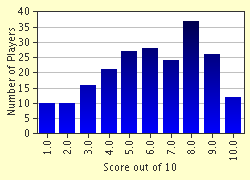Quiz Answer Key and Fun Facts
1. Lovers of Byzantine art are certain to know the answer to this question. What is the 'T' term for an individual piece used to create a mosaic?
2. A painting or carving with three adjoining compartments is typically called by what 'T' term of art history?
3. In a Christian church, this term refers to the two 'arms' of the church that form right angles with the nave, creating the cruciform shape of the building. What 'T' term of architecture fits this description?
4. A 'truqueur' is a person who practices what occupation related to the world of art?
5. We don't often talk about the shapes of paintings, as typically we find that paintings are rectangular. However, there have been many examples of circular paintings and/or reliefs in art history. These are called by what Italian 'T' term?
6. From Italian we return to French. What is the special characteristic of a 'trompe l'oeil' painting?
7. In the 1940s and 50s the Abstract Expressionist movement exploded on the New York art scene. Some members of the New York school, most notably Jackson Pollock, practiced a technique called 'action painting'. What was the parallel European version of this technique called?
8. Terracotta is a type of earthenware used in building or modeling. What color is terracotta, most typically?
9. What resinous secretion of certain pine (and some other) trees is distilled and used as a thinner for paints?
10. Tempera is a painting method using pigments mixed in emulsion with a colloidal vehicle. Which of these is most commonly used as the medium for tempera paints?
Source: Author
thejazzkickazz
This quiz was reviewed by our editing team before going online.
Any errors found in FunTrivia content are routinely corrected through our feedback system.

